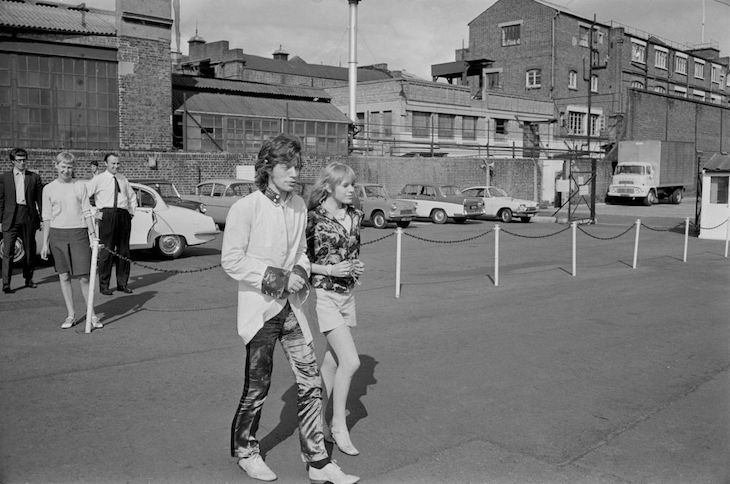The death of Marianne Faithfull last week at the age of 78 has got me thinking again about female beauty. The obituaries were full of descriptions of the singer and actress, who was, as the Daily Mail put it, “the poster girl for the Swinging Sixties” and “the sixties angel with big tits”. The Daily Telegraph flagged a quote from her one-time manager: “She was everything you could want in a woman that you couldn’t possibly have”. Cobblers.
Faithfull played the part speaking her lines as if she were a child
Faithfull, Mick Jagger’s girlfriend in the second half of the 1960s, was not beautiful. She had a timid girly voice, slim boyish hips and sad downward-sloping eyes.
I say this even though the Rolling Stones are one of my favourite bands (along with the Doors and the Velvet Underground), and despite Faithfull being very much part of their story in the late 1960s, when they began to achieve the greatness that would reach its peak in the first half of the 1970s.
While I love the music of the Stones and their crazy out-on-the-edge lifestyle, and despite liking much about Faithfull and admiring the way that, after breaking up with Jagger, she somehow survived living homeless for two years on the streets of Soho as a heroin addict in the 1970s, I cannot see her as beautiful.
Girl on a Motorcycle (1968), in which Faithfull starred with Alain Delon, is talked of as every man’s fantasy film given that she spends most of it on a powerful Harley Davidson in a black leather catsuit with a zipper all the way down the front and nothing on underneath. But she played the part speaking her lines as if she were a child, and as if she did not possess flesh or blood, but existed only in some ethereal out of body dimension.
The film ends with her driving her Harley Davidson so fast it crashes while she has a wishy-washy orgasm and dies. But to make the role she plays work demands an earthy beating pulse of a woman.
Those British women in the Swinging Sixties who truly were beautiful include Julie Christie; in Europe, Brigitte Bardot and Sophia Loren. Defining female beauty is not easy, of course, and attempts at pinning it down have gone on since the year dot.
But there are some rules. The most famous surviving work of art from the classical world that best encapsulates a definition of female beauty which has spanned the whole of history is the Venus Callipyge or Aphrodite Kallipygos.
This statue of the Goddess of Love, Beauty, Desire, and Fertility among other things, was created by a Roman sculptor in the 1st century BC, but is believed to be based on a much earlier Greek version. Its name derives from the Greek words κάλλος (beauty) and πυγη (buttocks). It depicts in spectacular fashion what my parent’s generation used to called “child bearing hips” as perhaps the most important aspect of female beauty.
No doubt such a view is verboten these days in the West, banned as sexist or something. We now live in a world where fashion models who are all too often the stick-thin opposite of child-bearing women are paraded about as if the epitome of female beauty.
I do not care. If any heterosexual man is honest, he finds generous and curvaceous hips and buttocks sexually attractive and thus beautiful, as he does what the Italians call “un seno prosperoso” (prosperous breasts), because that it is how nature has programmed him. Indeed, Christie, Bardot, and especially Loren, had all such attributes in spades – unlike Faithfull. Christie’s vital statistics (another banned phrase?) in her hey-day were 36” 24” 36”, Bardot’s 35” 23” 35” and Loren’s 38” 25” 38”.
Obviously, I realise that sexual attractiveness is not the only element that makes a woman beautiful, but we are here, above all, talking about young female beauty. With the rise of Christianity, depictions and definitions of this increasingly came to involve inner moral and spiritual as well as physical beauty; in a fusion of the Goddess of Love and the Virgin Mary.

A good example of the schizophrenia that this could cause is Botticelli’s Primavera from the late 15th century, in which there are two main female figures: Venus, who looks, not like the Goddess of Love at all, but like the Virgin Mary or your mother; and Flora, the Goddess of Spring, who looks irresistible.
Behind Flora is the nymph Chloris who has been “taken” by Zephyrus, the God of the West Wind, who is behind her. It is unclear if she consented! But as a result, Chloris has been transformed into Flora. Whereas Venus, the Goddess of Love, has an expression of pity and concern on her face as she stares out at the viewer, Flora, the Goddess of Spring, has the inviting yet defiant beginnings of a smile on hers. This was a revolutionary change in the depiction of women in art. Until then, their faces had been expressionless.
During the Renaissance, there were endless attempts to pin down in writing the nitty-gritty of female beauty. Naturally, the face, not just the body, was crucial. A key element was the Greek profile; the straight line from nose to forehead. As for the eyes, well obviously they had to be large, upward-turning, and shaped like almonds.
Agnolo Firenzuola, writing in the early 16th century in Tuscany, produced one of the most famous attempts at getting to the heart of the matter. Dialogo Delle Bellezze Delle Donne Intitolato Celso was based on his regular chats in a garden in Prato with four women.
Firenzuola wrote of the required physical attributes, but is famous for his list of the key extra-physical elements that female beauty requires. This drew on what Dante, Boccaccio and Petrarch had written before him. Here’s his list:
Leggiadria (loveliness) relating to carriage of the body “that is governed by a silent law that can be studied in no book”; grazia (grace) – “un non so che” – a je ne sais quoi – closely related to splendore (splendour) “fired by proportions that are also hidden”; vaghezza (vagueness) which “turns the mind of the spectator into a wanderer desiring to enjoy the beauty that inspires it”; venustà (pulchritude), “noble, chaste, and virtuous, springing from celestial rather than terrestrial love”; aria (impression), which “springs from an inner virtue, based on a healthy spirit”; and maestà (majesty) which is the “regal gravity of body, carriage, and speech that excites reverence and admiration”.
Firenzuola believed that the smile of a beautiful woman is a revelation of grace capable of transforming the world that makes her mouth a paradise; his words remind me of the half-smile on Flora’s face in Primavera.
During the Renaissance, there were endless attempts to pin down in writing the nitty-gritty of female beauty
In the 19th century, the French writer Stendhal defined beauty as “nothing more than the promise of happiness”. I would say it involves the promise also of danger, creative danger, but above all of joy. Marianne Faithfull promised nothing of the sort. She promised only danger of the worst kind.
Here’s my top 20 list of the most beautiful women in the world in the 20th and 21st centuries which I have drawn up without losing too much sleep over it.
It is my truth, if not the truth. It is obvious I have a weak spot for French and Italian women and women of Latino origin. I’m not sure why this is but am sure it is to do with the Mediterranean.
I exclude Greta Garbo, Marlene Dietrich and Ingrid Bergman on the grounds that they do not promise any happiness at all, let alone joy, perhaps because they are not from the Mediterranean. Audrey Hepburn also doesn’t make the cut on the grounds that she is too thin.
Here’s my list:
Brigitte Bardot, Sophia Loren, Julie Christie, Claudia Cardinale, Ava Gardner, Lauren Bacall, Marilyn Monroe, Monica Bellucci, Laetitia Casta, Claudia Schiffer, Penelope Cruz, Halle Berry, Anna Karina, Linda Cristal, Nastassja Kinski, Irene Papas, Jean Shrimpton, Beyoncé, Kate Moss. And, given her connection to The Spectator in so many ways, I cannot resist adding, yes, Nigella Lawson!








Comments